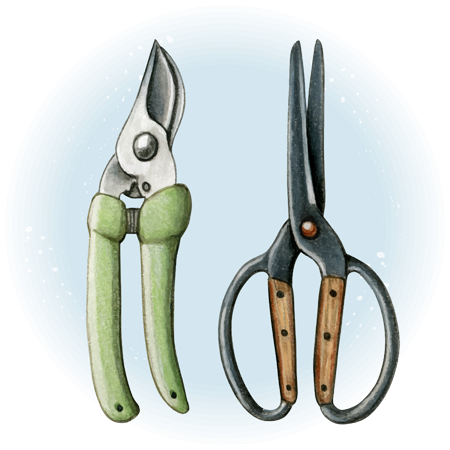Salvia Small Talk: Deadheading Deciduous, Woody Stem Sages

Removing withered Salvia blossoms that are beginning to go to seed is called deadheading — a form of pruning. This is trimming done in late spring and summer to make plants look tidier and encourage repeat blooming during the growing season. How to deadhead a Salvia depends on its form of growth, which may be one of four types: Rosette-growing herbaceous perennial; soft-stemmed deciduous or semi-evergreen sage; deciduous, woody-stemmed sage; or evergreen shrub. Many Salvias in each of these categories can thrive as annuals in areas where winters are too cold for perennial growth. Deadheading increases bloom for your buck, especially for sages grown as annuals.
Deciduous Salvias that combine soft herbaceous growth with stems that are woody toward the bottom of the plant are often called subshrubs. In their warmest USDA plant hardiness zones, they sometimes act like evergreens. But in areas with cold winters, they lose their foliage when temperatures drop and regain it in spring.
The native habitat of deciduous woody-stem Salvias isn’t limited to the American Southwest and Mexico, but almost all that we grow at Flowers by the Sea Farm and Online Nursery are from these areas. Here are some examples from our online catalog:
- Raspberry Autumn Sage (Salvia greggii ‘Raspberry’) from Texas and Northwest Mexico
- Red Velvet Mountain Sage (Salvia microphylla ‘Red Velvet’) from Southern Arizona and mountainous areas of Mexico
- Elk Lemon Light Jame Sage (Salvia x ‘Elk Lemon Light’), a hybrid related to Salvia x jamensis from sky islands in Mexico’s mountains
- Querétaro Mexican Sage (Salvia mexicana ‘Querétaro’) from Central Mexico, and
- Golden Delicious Pineapple Sage (Salvia elegans ‘Golden Delicious’) from Mexican pine and oak forest lands.
To improve a plant’s appearance and increase bloom, partially or completely remove stems of spent blossoms from deciduous, woody-stem Salvias throughout spring and summer. Then, August is a good time to cut back entire growth by one-third to one-half to stimulate strong fall flowering.
Bypass pruners — secateurs — or a sharp pair of scissors are sufficient for trimming these thin stemmed plants.
Questions and More Information
The plant description pages in our online catalog contain a wealth of information about plant characteristics and needs. Page features include a button saying, “How to Prune this Plant.” It leads to a pop-up box identifying the plant’s form of growth and basic information about pruning.
If you have more questions about pruning or any of the plants we grow please contact us. We’re glad to listen and share what we know.

 Salvia mexicana 'Queretaro'
Salvia mexicana 'Queretaro'  Salvia microphylla 'Red Velvet'
Salvia microphylla 'Red Velvet'  Salvia elegans 'Golden Delicious'
Salvia elegans 'Golden Delicious'  Salvia greggii 'Raspberry'
Salvia greggii 'Raspberry'  Salvia x 'Elk Lemon Light'
Salvia x 'Elk Lemon Light'
Comments
There are no comments yet.